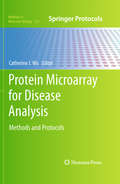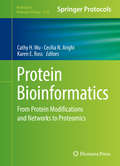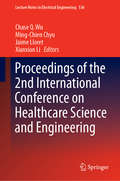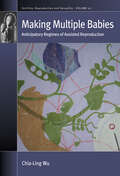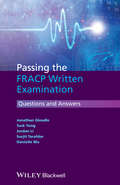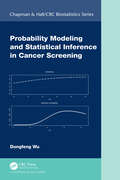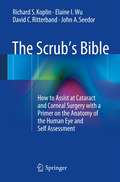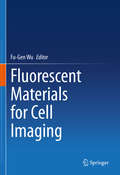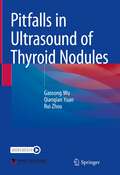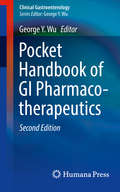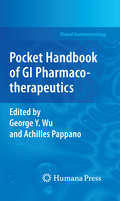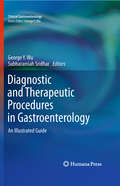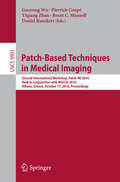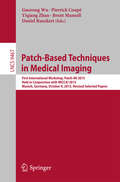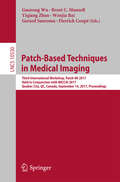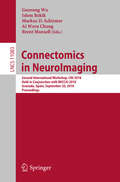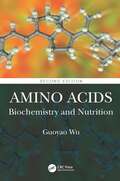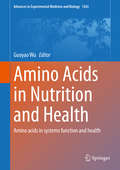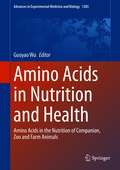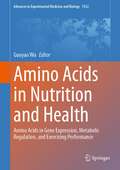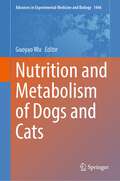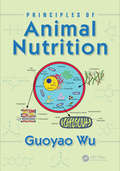- Table View
- List View
Circadian Pharmacokinetics
by Baojian Wu Danyi Lu Dong DongThis book summarizes the recent advances for the understanding of circadian clock system in the regulation of drug metabolism and pharmacokinetics. Basic knowledge in the field of circadian clock and pharmacokinetics are systemically introduced to make it easier for readers to understand the entire book's contents. The rhythmic expression of DMEs (drug-metabolizing enzymes) and transporters are summarized, and the underlying mechanisms thereof (i.e., regulation by circadian oscillators) are discussed. Typically, evidence for the DME- and transporter-mediated chronopharmacokinetics, chronotoxicity and chronoefficacy are highlighted in this book.
Protein Microarray for Disease Analysis
by Catherine J. WuProtein microarrays have been used for a wide variety of important tasks, such as identifying protein-protein interactions, discovering disease biomarkers, identifying DNA-binding specificity by protein variants, and for characterization of the humoral immune response. In Protein Microarray for Disease Analysis: Methods and Protocols, expert researchers provide concise descriptions of the methodologies currently used to fabricate microarrays for the comprehensive analysis of proteins or responses to proteins that can be used to dissect human disease. These methodologies are the toolbox for revolutionizing drug development and cell-level biochemical understanding of human disease processes. Beginning with a section on protein-detecting analytical microarrays, the volume continues with sections covering antigen microarrays for immunoprofiling, protein function microarrays, the validation of candidate targets, proteomic libraries, as well as signal detection strategies and data analysis techniques. Written in the highly successful Methods in Molecular BiologyTM series format, chapters include introductions to their respective topics, lists of the necessary materials and reagents, step-by-step, readily reproducible laboratory protocols, and key tips on troubleshooting and avoiding known pitfalls. Practical and cutting-edge, Protein Microarray for Disease Analysis: Methods and Protocols serves as a solid framework to aid scientists in understanding how protein microarray technology is presently developing and how it can be applied to transform our analysis of human disease.
Protein Bioinformatics: From Protein Modifications and Networks to Proteomics (Methods in Molecular Biology #1558)
by Cathy H. Wu Cecilia N. Arighi Karen E. RossThis volume introduces bioinformatics research methods for proteins, with special focus on protein post-translational modifications (PTMs) and networks. This book is organized into four parts and covers the basic framework and major resources for analysis of protein sequence, structure, and function; approaches and resources for analysis of protein PTMs, protein-protein interactions (PPIs) and protein networks, including tools for PPI prediction and approaches for the construction of PPI and PTM networks; and bioinformatics approaches in proteomics, including computational methods for mass spectrometry-based proteomics and integrative analysis for alternative splice isoforms, for functional discovery. Written in the highly successful Methods in Molecular Biology series format, chapters include introductions to their respective topics, lists of the necessary materials and reagents, step-by-step, readily reproducible laboratory or computational protocols, and tips on troubleshooting and avoiding known pitfalls.Cutting-edge and thorough, Protein Bioinformatics: From Protein Modifications and Networks to Proteomics is a valuable resource for readers who wish to learn about state-of-the-art bioinformatics databases and tools, novel computational methods, and future trends in protein and proteomic data analysis in systems biology. This book is useful to researchers who work in the biotechnology and pharmaceutical industries, and in various academic departments, such as biological and medical sciences and computer sciences and engineering.
Proceedings of the 2nd International Conference on Healthcare Science and Engineering (Lecture Notes in Electrical Engineering #536)
by Chase Q. Wu Ming-Chien Chyu Jaime Lloret Xianxian LiThis book presents a compilation of selected papers from the 2nd International Conference on Healthcare Science and Engineering (Healthcare 2018). The work focuses on novel computing, networking, and data analytics techniques for various issues in healthcare. The book is a valuable resource for academic researchers and practitioners working in the field.
Making Multiple Babies: Anticipatory Regimes of Assisted Reproduction (Fertility, Reproduction and Sexuality: Social and Cultural Perspectives #52)
by Chia-Ling WuHuman beings have been producing more twins, triplets, and quadruplets than ever before, due to the expansion of medically assisted conception. This book analyzes the anticipatory regimes of making multiple babies. With archival documents, participant observation, in-depth interviews, and registry data, this book traces the global and local governance of the assisted reproductive technologies (ARTs) used to tackle multiple pregnancy since the 1970s, highlighting the early promotion of single embryo transfer in Belgium and Japan and the making of the world’s most lenient guidelines in Taiwan.
Clinical Nuclear Medicine Neuroimaging: An Instructional Casebook
by Dafang WuThis book serves as a casebook for clinical nuclear medicine neuroimaging. Clinical interpretation of nuclear medicine neuroimaging studies is often challenging, mainly due to the complexity of neuroanatomy and a lack of supportive reference books. This is an unmet need in many teaching hospitals. Utilizing a hands-on, case-based approach, this textbook guides readers through clinical nuclear medicine neuroimaging of major neurological diseases and conditions, including dementia, epilepsy, and brain death. Included here are basic guidelines and techniques for nuclear medicine neuroimaging practices, set alongside case examples that include standardized imaging display and detailed interpretation. Each chapter begins with examples of normal brain imaging as a reference point for the remainder of the chapter, which then presents detailed case examples of these diseases through various imaging techniques. Each of the cases highlights clinical and imaging key findings and precise impressions. This is an ideal guide for residents, fellows, and even practicing nuclear medicine physicians as a reference and teaching tool for neuroimaging in clinical nuclear medicine. It will be of significant value to residents, trainees, and young physicians in preparation for their in-service tests and board examinations.
Passing the FRACP Written Examination
by Danielle Wu Tuck Yong Jonathan Gleadle Surjit Tarafdar Jordan LiPassing the FRACP Written Examination is the ideal study aid for candidates of the Fellow of the Royal Australasian College of Physicians (FRACP) examination. Written by a team of physicians based at Flinders Medical Centre, and covering the key components of the FRACP basic training syllabus, this guide presents over 500 multiple-choice questions on all major topics covered in the examination. It provides coverage of rapidly evolving topics such as healthcare in an ageing population, disparity in indigenous health outcomes, advances in molecular science and genetics, and the complexity of care arising from multiple chronic illnesses. Questions echo the written examination, including those on both 'Basic Sciences' and 'Clinical Practice'.Many of the questions are similar to those in the actual examination; others are designed to 'teach' particularly important issues or to draw attention to contemporary topics. Each question has an answer that fully explains the correct and incorrect responses.This study aid also includes: * Questions and answers linked to a reference that is usually the best and most contemporary review for further reading and as additional guide to study* QR code links to all the references* Hints and tips from previous candidates on examination strategies* A large number of the new style extended matching questions (EMQs).This brand new study aid gives all FRACP candidates a unique opportunity to practise for the examination and improve their medical knowledge of the syllabus as a whole.
Probability Modeling and Statistical Inference in Cancer Screening (Chapman & Hall/CRC Biostatistics Series)
by Dongfeng WuCancer screening has been carried out for six decades – however, there are many unsolved problems: how to estimate key parameters involved in screenings, such as sensitivity, the time duration in the preclinical state (i.e., sojourn time), and time duration in the disease-free state; how to estimate the distribution of lead time, the diagnosis time advanced by screening; how to evaluate the long-term outcomes of screening, including the probability of overdiagnosis among the screen-detected; when to schedule the first exam based on one’s current age and risk tolerance; and when to schedule the upcoming exam based on one’s screening history, age, and risk tolerance. These problems need proper probability models and statistical methods in order to be dealt with. Features: This book gives a concise account of the analysis of cancer screening data, using probability models and statistical methods. Real data sets are provided so that cancer researchers and statisticians can apply the methods in the learning process. It develops statistical methods in the commonly used disease progressive model. It provides solutions to practical problems and introduces open problems. It provides a framework for the most recent developments based on the author’s research. The book is primarily aimed at researchers and practitioners from biostatistics and cancer research. Readers should have the prerequisite knowledge of calculus, probability, and statistical inference. The book could be used as a one-semester textbook on the topic of cancer screening methodology for a graduate-level course.
The Scrub's Bible
by Elaine I. Wu David C. Ritterband John A. Seedor Richard S. KoplinDirected at the growing number of untutored personnel aspiring to enter the disciplines of ophthalmic technicianry and surgical assisting, The Scrub's Bible represents an entry level guide to understanding the human eye, its basic anatomy, and physiology. Absorbing this information serves as the foundation for the authors, who are all skilled and respected eye surgeons, educators, and surgery center owners, to draw the reader through the fundamentals of the two most common areas of ophthalmic surgery: cataract and corneal/refractive surgery. The Scrub's Bible is a comprehensive yet easy-to-read tool that is broken down into discreet and understandable elements, meant to avoid the intimidating rhetoric of a standard reference.
Fluorescent Materials for Cell Imaging
by Fu-Gen WuThis book focuses on the latest fluorescent materials for cell imaging. Cell imaging is a widely used basic technique that helps scientists gain a better understanding of biological functions through studies of cellular structure and dynamics. In the past decades, the development of a variety of new fluorescent materials has significantly extended the applications of cellular imaging techniques. This book presents recently developed fluorescent materials, including semiconductor quantum dots, carbon dots, silicon nanoparticles, metal nanoclusters, upconversion nanoparticles, conjugated polymers/polymer dots, aggregation-induced emission (AIE) probes, and coordination compounds, used for various cellular imaging purposes. It will appeal to cell biologists and other researchers in academia, industry and clinical settings who are interested in the technical development and advanced applications of fluorescence imaging in cells, tissues and organisms to explore the mechanisms of biological functions and diseases.
Pitfalls in Ultrasound of Thyroid Nodules
by Gaosong Wu Qianqian Yuan Rui ZhouThyroid nodules with benign signs might be subjectively diagnosed as malignant, leading to over treatment, and nodules with malignant signs might be regarded as benign causing insufficient curing. In order to improve the accuracy rate of thyroid nodules, this book analysed ultrasound diagnosis for thyroid nodules in multiple difficult and misdiagnosed cases from thyroid surgeons’ perspective and closely combined ultrasound imaging with clinical information, including ultrasound images and palpation of thyroid nodules, ultrasound detection video, gross specimen and pathologic diagnosis to interpret the ultrasound images of thyroid nodules, which can be a reference for thyroid surgeons and beginner.This is the first book which has systematically summarized the ultrasound thyroid nodules from the perspective of surgeons, closely combining the imaging and clinical characteristics.Contains abundant clinical cases, and can be used as a teaching book for beginner and an expert-led training course.Help surgeons to better carry out clinical work, making up for the lack of knowledge in anatomy and clinical pathology.Helps surgeons to perform the preoperative ultrasound evaluation, in order to decrease the missed and misdiagnosed nodules.
Pocket Handbook of GI Pharmacotherapeutics
by George Y. WuThis new edition is a comprehensive, yet concise text that provides current treatment protocols and practical pharmacological information for GI Disease. Each chapter addresses a specific GI disease or condition and provides a list of all agents available for that condition, including all brand and generic names, indications, contraindications, lactation and pregnancy information, doses, routes of administration, duration, and relative cost. The text is also supplemented with tables, algorithms, and key references. Written by experts in the field, Pocket Handbook of GI Pharmacotherapeutics, Second Edition is a valuable and portable resource of use to anyone involved in the treatment of patients with GI disease.
Pocket Handbook of GI Pharmacotherapeutics
by George Y. Wu Achilles PappanoAlthough there are many pharmacology texts, and electronic sources of drug information relating to GI disorders, they are frequently encyclopedic, and practical information can be difficult to find. In Pocket Handbook of GI Pharmacotherapeutics, George Wu and Achilles Pappano create a text that combines the current treatment protocols and practical pharmacological information of prominent GI disorders for the first time. Chapters are disease specific, and contain treatment algorithms and therapy guides that present all the essential information in a compact, easy to reference handbook. The text contains practical clinical information in a highly accessible format, including keys for relative costs and the FDA pregnancy rating system for drug safety. Informative and unique, Pocket Handbook of GI Pharmacotherapeutics is a must have reference for any internist, gastroenterologist or general practioner who endeavors to provide better treatment of their patients.
Chronic Viral Hepatitis: Diagnosis and Therapeutics (Clinical Gastroenterology)
by George Y. Wu Kirti ShettyChronic viral hepatitis affect hundreds of millions of people worldwide, and each year millions more people become infected. In Chronic Viral Hepatitis, Second Edition, a panel of distinguished clinicians and clinical investigators build upon the first edition by comprehensively reviewing all the relevant new information regarding resistance, side effects, and therapies for chronic viral hepatitis. The text covers recent advances in the understanding of pathogenesis of viral hepatitis while discussing promising agents in development for its treatment. The authors devote special attention to reactivation of hepatitis B with chemotherapy and immunosuppression, herbal and non-traditional therapies, chronic viral hepatitis in the pediatric population, and immunology and immunotherapy of HCV and provide relative costs for all diagnostic and therapeutic options. Authoritative and up-to-date, Chronic Viral Hepatitis, Second Edition offers today's gastroenterologists, internists, hepatologists, and infectious disease specialists a practical guide to the recognition, diagnosis and treatment of chronic viral hepatitis from a multidisciplinary approach.
Diagnostic and Therapeutic Procedures in Gastroenterology
by George Y. Wu Subbaramiah SridharDiagnostic and Therapeutic Procedures in Gastroenterology: An Illustrated Guide is a comprehensive volume describing procedures for the gastrointestinal tract in a simple way. Artistic illustrations are provided to educate the physician about procedures, and to provide not only clear descriptions of the changes in the anatomy and physiology, but also to provide advice on medical management of the post-procedure patient. Clear, detailed, artist-rendered illustrations of the anatomy are included as well as appropriate, radiological images. Chapters describe in detail the indications, contraindications, anatomical alterations, and physiological alterations that result from various operations and procedures. Comparisons between alternative operations, complications, medical management issues, and costs are also discussed. Diagnostic and Therapeutic Procedures in Gastroenterology: An Illustrated Guide is a unique volume, written primarily for primary care physicians and general internists. It is also suitable for medical students, residents, nurses and nurse practitioners, nutritionists, dietitians and various subspecialists, who take care of patients with gastrointestinal disorders.
Patch-Based Techniques in Medical Imaging
by Guorong Wu Pierrick Coupé Yiqiang Zhan Brent C. Munsell Daniel RueckertThis book constitutes the refereed proceedings of the Second International Workshop on Patch-Based Techniques in Medical Images, Patch-MI 2016, which was held in conjunction with MICCAI 2016, in Athens, Greece, in October 2016. The 17 regular papers presented in this volume were carefully reviewed and selected from 25 submissions. The main aim of the Patch-MI 2016 workshop is to promote methodological advances within the medical imaging field, with various applications in image segmentation, image denoising, image super-resolution, computer-aided diagnosis, image registration, abnormality detection, and image synthesis.
Patch-Based Techniques in Medical Imaging
by Guorong Wu Pierrick Coupé Yiqiang Zhan Brent Munsell Daniel RueckertThis book constitutes the thoroughly refereedpost-workshop proceedings of the First International Workshop on Patch-based Techniquesin Medical Images, Patch-MI 2015, which was held in conjunction with MICCAI2015, in Munich, Germany, in October 2015. The 25 full papers presented in this volume werecarefully reviewed and selected from 35 submissions. The topics covered are suchas image segmentation of anatomical structures or lesions; image enhancement;computer-aided prognostic and diagnostic; multi-modality fusion; mono and multimodal image synthesis; image retrieval; dynamic, functional physiologic andanatomic imaging; super-pixel/voxel in medical image analysis; sparsedictionary learning and sparse coding; analysis of 2D, 2D+t, 3D, 3D+t, 4D, and4D+t data.
Patch-Based Techniques in Medical Imaging
by Guorong Wu Brent C. Munsell Yiqiang Zhan Wenjia Bai Gerard Sanroma Pierrick CoupéThis book constitutes the refereed proceedings of the Second International Workshop on Patch-Based Techniques in Medical Images, Patch-MI 2016, which was held in conjunction with MICCAI 2016, in Athens, Greece, in October 2016. The 17 regular papers presented in this volume were carefully reviewed and selected from 25 submissions. The main aim of the Patch-MI 2016 workshop is to promote methodological advances within the medical imaging field, with various applications in image segmentation, image denoising, image super-resolution, computer-aided diagnosis, image registration, abnormality detection, and image synthesis.
Connectomics in NeuroImaging: First International Workshop, Cni 2017, Held In Conjunction With Miccai 2017, Quebec City, Qc, Canada, September 14, 2017, Proceedings (Lecture Notes in Computer Science #10511)
by Guorong Wu Islem Rekik Markus D. Schirmer Ai Wern Chung Brent MunsellThis book constitutes the refereed proceedings of the Second International Workshop on Connectomics in NeuroImaging, CNI 2018, held in conjunction with MICCAI 2018 in Granada, Spain, in September 2018. The 15 full papers presented were carefully reviewed and selected from 20 submissions. The papers deal with new advancements in network construction, analysis, and visualization techniques in connectomics and their use in clinical diagnosis and group comparison studies as well as in various neuroimaging applications.
Amino Acids: Biochemistry and Nutrition
by Guoyao WuFollowing its predecessor, the second edition of Amino Acids: Biochemistry and Nutrition presents exhaustive coverage of amino acids in the nutrition, metabolism and health of humans and other animals. Substantially revised, expanded and updated to reflect scientific advances, this book introduces the basic principles of amino acid biochemistry and nutrition, while highlighting the current knowledge of the field and its future possibilities. The book begins with the basic chemical concepts of amnio acids, peptides and proteins, and their digestion and absorption. Subsequent chapters cover cell-, tissue-, and species-specific synthesis and catabolism of amino acids and related bioactive metabolites, and the use of isotopes to study amino acids metabolism in cells and the body. The book details protein turnover, physiological functions of amino acids, as well as both the regulation and inborn errors of amino acid metabolism. The book concludes with a presentation on human and animal dietary requirements of amino acids and evaluates dietary protein quality. Features: Encompasses a comprehensive coverage of basic to applied concepts in amino acid metabolism in humans and other animals. Highlights important roles of dietary amino acids and protein intake in growth, physical performance and health, including sarcopenia mitigation and immunity. Discusses concerns over the excess intakes of amino acids or protein in the development of diseases, including cardiovascular disorders, diabetes and cancers, as well as bone integrity Each chapter contains select references to provide comprehensive reviews and original experimental data on the topics discussed. Each chapter is backed by original experimental data on various topics discussed and contains select references to aid the reader further in research. Written by Distinguished Professor of Animal Nutrition, Guoyao Wu, Ph.D., this book is an authoritative reference for students and researchers in both biomedicine and agriculture.
Amino Acids in Nutrition and Health: Amino acids in systems function and health (Advances in Experimental Medicine and Biology #1265)
by Guoyao WuThis edited volume comprehensively highlights recent advances in the metabolism, nutrition, physiology, and pathobiology of amino acids in all the systems of humans and other animals (including livestock, poultry, companion animals, and fish). It enables readers to understand the crucial roles of amino acids and their metabolites in the health and diseases of the circulatory, digestive, endocrine, immune, muscular, nervous, reproductive, respiratory, skeletal, and urinary systems, as well as the sense organs (eyes, ears, nose, skin, and tongue). Readers will learn that amino acids are not only the building blocks of protein, but are also signalling molecules, as well as regulators of gene expression, metabolic processes and developmental changes in the body. This knowledge will guide nutritional practices to improve the growth, development and health of humans and other animals, as well as prevent and treat chronic (e.g., obesity, diabetes, and cardiovascular disorders) and infectious (e.g., bacterial, fungal, parasite, and viral) diseases. Editor of this volume is an internationally recognized expert in nutritional biochemistry. He has over 38 years of experience with research and teaching at world-class universities in the area of amino acid biochemistry, nutrition, and physiology. He has published more than 625 papers in peer-reviewed journals, 62 chapters in books, and authored two text/reference books, with an H-index of 117 and more than 55,000 citations in Google Scholar. This publication is a useful reference for professionals as well as undergraduate and graduate students in animal science, biochemistry, biomedical engineering, biology, human medicine, food science, kinesiology, nursing, nutrition, pharmacology, physiology, toxicology, veterinary medicine, and other related disciplines. In addition, all chapters provide general and specific references to amino acids in systems health for researchers and practitioners in biomedicine, animal and plant agriculture, and aquaculture, and for government policy makers.
Amino Acids in Nutrition and Health: Amino Acids in the Nutrition of Companion, Zoo and Farm Animals (Advances in Experimental Medicine and Biology #1285)
by Guoyao WuAmino acids (AAs) are not only building blocks of protein, but are also signalling molecules as well as regulators of gene expression and the protein phosphorylation cascade. Additionally, AAs are key precursors for syntheses of hormones and low-molecular weight nitrogenous substances with each having enormous biological importance. For example, physiological concentrations of AA metabolites (e.g., nitric oxide, polyamines, glutathione, taurine, thyroid hormones, and serotonin) are required for cell functions. Growing evidence shows that humans and animals have dietary requirements for all proteinogenic AAs. Mammals, birds and fish also have species- and age-dependent needs for some AA-related substances. However, elevated levels of other products (e.g., ammonia, homocysteine, H2S, and asymmetric dimethylarginine) are pathogenic factors for neurological disorders, oxidative stress, and cardiovascular disease. Thus, optimal amounts of AAs and their ratios in diets and circulation are crucial for whole body homeostasis and health. Adequate provision of one or a mixture of functional AAs or metabolites may be beneficial for ameliorating health problems at various stages of the life cycle (e.g., fetal growth restriction, neonatal morbidity and mortality, weaning-associated intestinal dysfunction and wasting syndrome, obesity, diabetes, cardiovascular disease, the metabolic syndrome, and infertility). Dietary supplementation of these nutrients can also optimize the efficiency of metabolic transformations to enhance muscle growth, milk production, and athletic performance, while preventing excess fat deposition and reducing adiposity. Therefore, functional AAs hold great promise in improving the growth, health and well-being of individuals.Chapter 7 is available open access under a Creative Commons Attribution 4.0 International License via link.springer.com.
Amino Acids in Nutrition and Health: Amino Acids in Gene Expression, Metabolic Regulation, and Exercising Performance (Advances in Experimental Medicine and Biology #1332)
by Guoyao WuThis book explains about amino acids (AAs) which are not only building blocks of protein, but are also signaling molecules as well as regulators of gene expression and the protein phosphorylation cascade. Additionally, AAs are key precursors for syntheses of hormones and low-molecular-weight nitrogenous substances with each having enormous biological importance. For example, physiological concentrations of AA metabolites (e.g., nitric oxide, polyamines, glutathione, taurine, thyroid hormones, and serotonin) are required for cell functions. Growing evidence shows that humans and animals have dietary requirements for all proteinogenic AAs. Mammals, birds, and fish also have species- and age-dependent needs for some AA-related substances. However, elevated levels of other products (e.g., ammonia, homocysteine, H2S, and asymmetric dimethylarginine) are pathogenic factors for neurological disorders, oxidative stress, and cardiovascular disease. Thus, optimal amounts of AAs and their ratios in diets and circulation are crucial for whole-body homeostasis and health. Adequate provision of one or a mixture of functional AAs or metabolites may be beneficial for ameliorating health problems at various stages of the life cycle (e.g., fetal growth restriction, neonatal morbidity and mortality, weaning-associated intestinal dysfunction and wasting syndrome, obesity, diabetes, cardiovascular disease, the metabolic syndrome, and infertility). Dietary supplementation of these nutrients can also optimize the efficiency of metabolic transformations to enhance muscle growth, milk production, and athletic performance, while preventing excess fat deposition and reducing adiposity. Therefore, functional AAs hold great promise in improving the growth, health, and well-being of individuals.
Nutrition and Metabolism of Dogs and Cats (Advances in Experimental Medicine and Biology #1446)
by Guoyao WuThis book provides new knowledge about the nutrition and metabolism, as well as the roles of nutrients in the immunity, health, and management of companion animals (dogs and cats). The domestic dog (facultative carnivore) and the domestic cat (obligate carnivore) have evolved differentially in their digestive tract, nutrition, metabolism, chemical sensing, and feeding behavior. These animals have been human companions for at least 12,000 and 9,000 years, respectively, and continue to contribute to the mental health and well-being of children, adolescents, and adults. Both dogs and cats have become increasingly popular in many countries and worldwide over the past decades. Comprehensive update about how the animals utilize dietary nutrients for optimum growth, development, and health is beneficial for their owners, as well as students and researchers. Chapter 4: Characteristics of Nutrition and Metabolism in Dogs and Cats is available open access under a Creative Commons Attribution 4.0 International License
Principles of Animal Nutrition
by Guoyao WuAnimals are biological transformers of dietary matter and energy to produce high-quality foods and wools for human consumption and use. Mammals, birds, fish, and shrimp require nutrients to survive, grow, develop, and reproduce. As an interesting, dynamic, and challenging discipline in biological sciences, animal nutrition spans an immense range from chemistry, biochemistry, anatomy and physiology to reproduction, immunology, pathology, and cell biology. Thus, nutrition is a foundational subject in livestock, poultry and fish production, as well as the rearing and health of companion animals. This book entitled Principles of Animal Nutrition consists of 13 chapters. Recent advances in biochemistry, physiology and anatomy provide the foundation to understand how nutrients are utilized by ruminants and non-ruminants. The text begins with an overview of the physiological and biochemical bases of animal nutrition, followed by a detailed description of chemical properties of carbohydrates, lipids, protein, and amino acids. It advances to the coverage of the digestion, absorption, transport, and metabolism of macronutrients, energy, vitamins, and minerals in animals. To integrate the basic knowledge of nutrition with practical animal feeding, the book continues with discussion on nutritional requirements of animals for maintenance and production, as well as the regulation of food intake by animals. Finally, the book closes with feed additives, including those used to enhance animal growth and survival, improve feed efficiency for protein production, and replace feed antibiotics. While the classical and modern concepts of animal nutrition are emphasized throughout the book, every effort has been made to include the most recent progress in this ever-expanding field, so that readers in various biological disciplines can integrate biochemistry and physiology with nutrition, health, and disease in mammals, birds, and other animal species (e.g., fish and shrimp). All chapters clearly provide the essential literature related to the principles of animal nutrition, which should be useful for academic researchers, practitioners, beginners, and government policy makers. This book is an excellent reference for professionals and a comprehensive textbook for senior undergraduate and graduate students in animal science, biochemistry, biomedicine, biology, food science, nutrition, veterinary medicine, and related fields.

